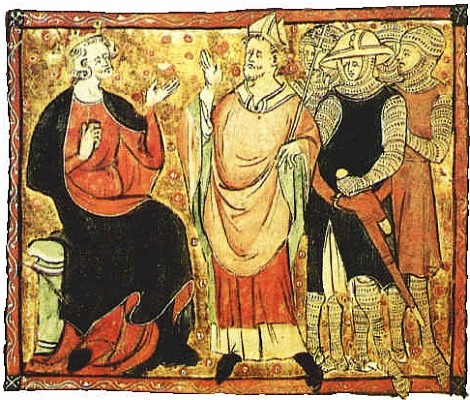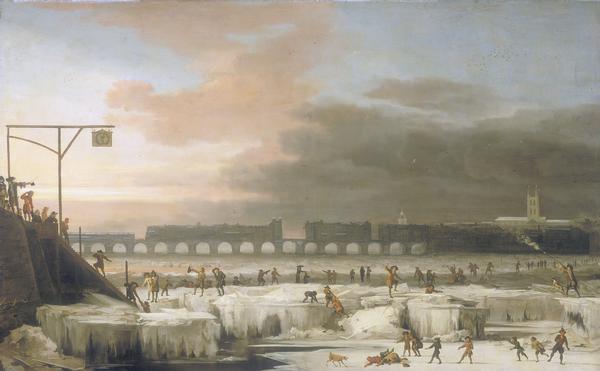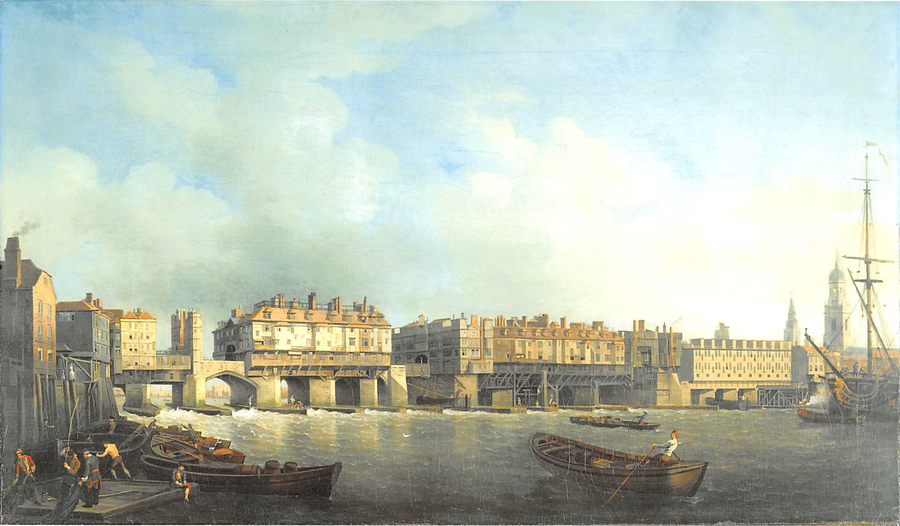London Bridge
For me, (the old) London Bridge is one of the most evocative and iconic secular structures in sixteenth century England.

Detail of Old London Bridge on the 1632 oil painting View of London Bridge by Claude de Jongh, in the Yale Center for British Art. Public domain. From Wikipedia.
This was the first stone built bridge on the site, although there had been many wooden bridges previously. It was commissioned by King Henry II, the work beginning in 1176 and completing in 1209.
In the middle of the bridge was the Chapel of St Thomas On the Bridge, dedicated to Thomas Becket the murdered archbishop. The chapel was the official start of pilgrimages to Becket’s shrine in Canterbury (see The Canterbury Tales by Geoffrey Chaucer).

14th-century depiction of Becket with King Henry II. Public domain. From Wikipedia.
There were fortified gates at both ends, a road down the middle, and both sides were lined with shops that had houses above them. As early as 1358 there were apparently 138 premises on the bridge.
Allowing the shops on the bridge was a way to help pay for maintenance.
By the seventeenth century there were fewer, larger houses, although most were 4 or 5 stories tall.

Drawing of London Bridge from a 1682 panorama. Public domain. From Wikipedia.
The bridge was 926 feet long and the roadway running between the premises was only 12 feet wide.
It comprised 19 arches and 1 wooden drawbridge which could be raised to allow passage of taller ships. The arches each spanned approximately 24 feet. The arches rested on stone piers each of which was about 20 feet wide and surrounded by a cofferdam that was in turn surrounded by a starling of loose rock.
With so many wide starlings the tidal flow had only about 230 feet left to flow through. So the tidal waters roared through and could cause a height differential between the upriver and downriver portions of up to 6 feet. The impeded flow also meant the upriver portion could freeze over.

The Frozen Thames (1677) by Abraham Hondius in the Museum of London, showing Old London Bridge and Southwark Cathedral at right. Public domain. From Wikipedia.
It remained the only bridge across the Thames in London until 1750 (when Westminster bridge opened) and was in almost continual use until 1831/2, having been in use for 622 years.

London Bridge in 1757 just before the removal of the houses, by Samuel Scott. Public domain. From Wikipedia.
What an amazing structure and fascinating history.
Let's recap:
The work began in 1176, it took 33 years to build, the houses and shops were replaced several times.
Each span was 24 feet wide and each starling was 20 feet wide, so it essentially forced the river Thames into half the width it normally had. No wonder it created a weir and frequently iced over!
It was the only bridge over the Thames until Westminster bridge opened in 1750. The only other bridge was way to the west, in Kingston-upon-Thames...one of the locations in Predestination. So if you wanted to cross the river you had three options
1) used London bridge
2) rode or walked for 5 hours to Kingston and crossed the bridge there
3) took a wherry (basically a rowing boat)
No wonder London bridge was so important and had such traffic congestion that 'driving' on a specific side of the road evolved as a natural rule. Why the left side? I don't know this for fact, but I would guess that it feels safer to keep strangers on your right hand side (if you are right-handed) so you can more easily draw a sword and defend yourself if necessary.
Hopefully you are now as fascinated with London bridge as I am, and can understand why the bridge features so much in Predestination: The Bloodstone of Boiorix.